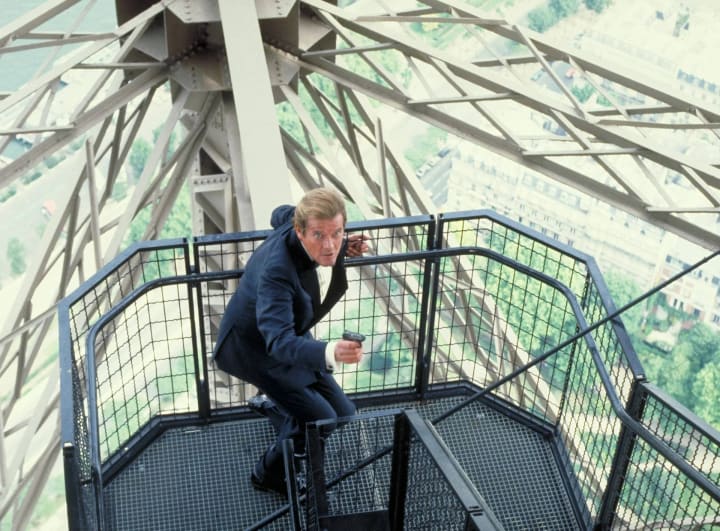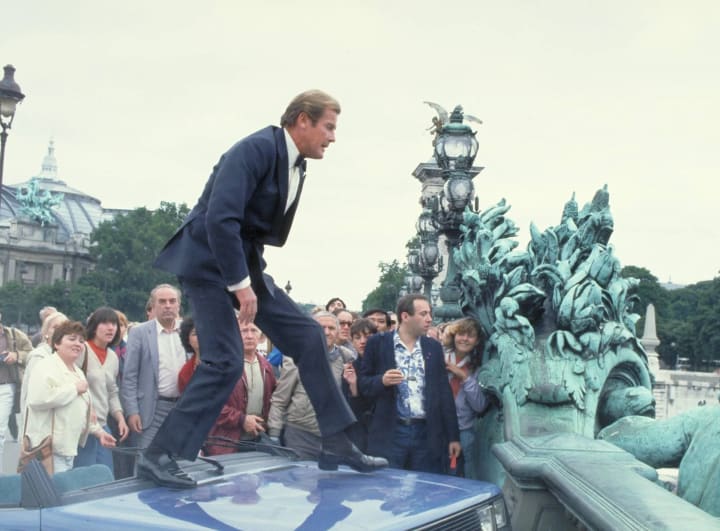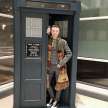#60yearsofJamesBond: A View to a Kill
In the second instalment of a series celebrating 60 years of the James Bond franchise, I look back at the final film to feature Roger Moore in the lead role.

"A View to a Kill" was, in many ways, an ending for the Bond franchise. A full stop on a type of Bond film that dominated the series for many years; an ending for various players who had become intrinsic parts of the series and its continued success. Over the years, it is one that, like a fair amount of the late 70s/early 80s Bond films, has come in for a large amount of criticism, and is one that Bond fans and aficionados do not look back on with much affection. Many take issue with the campy comedy. Some take issue with Roger Moore's advancing age. Others take issue with the story and the plot, as well as some of the guest acting from Christopher Walken, Grace Jones and Tanya Roberts. However, to this Bond fan, "A View to a Kill" does represent a bridge between the previous thirteen films, and what was to come later under Timothy Dalton and Pierce Brosnan, with some attempts to bring the Bond films forward into the 1980s. It's just a shame that there's also plenty of things holding this film back - often things that, if the producers were more daring, wouldn't have been problems.

Like pretty much every Bond film of the Moore era, we start out with an action packed pre-titles sequence, which, by a series of highly improbable events, turns out to be connected in an unexpected way to the main plot. Someone is leaking intelligence secrets to the Russian state, and the prime candidate is Anglo/French industrialist Max Zorin. Thus, we end up following improbable coincidence after improbable coincidence, until we reach the point where Zorin wants to flood Silicone Valley. This film's grip on rational logic may be slightly lacking. However, if you're taking a Bond film to task over a lack of logic, then I'm afraid you may be directing your ire at the wrong franchise. Practically every Bond film has improbable leaps of logic, and "A View to a Kill" is no exception. It may lean on this element a little more than other Bond films, but, make no mistake, this is a trope the franchise has been relying on since its inception. However, this film does rely on this element to an industrial level, and it feels like, in many ways, the writers were simply making this up as they went along. The whole plotline about Zorin being a Russian agent is dumped as soon as the first third of the film is over, and then it is never brought up again. In fact, the film goes to great pains to pretend that Russia are interested in Zorin for a whole host of other reasons, none of which are properly explained. That is, in many ways, part of the charm with "A View to a Kill": if you are willing to forgive the fact that the film is practically plotless (or, at least, the film does have a plot, but it is one that makes no sense), then there the major set pieces, which are as exciting as any Bond film of the time. The opening pre-titles may not be a classic, but the ice chase remains a fun set-piece that is actually credited with inspiring the sharp uptake in snowboarding in the late 1980s! (This sequence is ruined, somewhat, by the use of a cover of the Beach Boys song California Girls, which does kill any dramatic mood the sequence may have been going for), while the final fight atop the Golden Gate bridge remains a high point (in more ways that one) for the final confrontations between Bond and his nemesis'.

Speaking of villains, I think its time we talked about our main villain properly, as he is one of the most interesting Bond villains in the series, both in terms of his character and in terms of the actor playing him. Christopher Walken, one of the most well-respected and admired actors of his generation, takes on the part of Max Zorin, and his performance here stands as one of the most notable villain turns in the series. Despite the film's lukewarm reputation, I think many fans will say that he gives a winning turn, and he really pushes the limits of a Bond villain. In many sections of the film, it seems like the producers and director are focusing more on Zorin then they are on Bond, and Zorin's psychopathic behaviour makes a change from the slightly more realistic actions and ambitions of the 1980s Bond villains. Walken has a huge on-screen presence; not in an overly dominating, starry way, but just by giving a performance full of interesting choices and an inability to predict where he will take the part next. Don't even try to guess if you're watching this for the first time, because Walken will always surprise you. He offers a very different silhouette to the Bond villains of the past, who have often been classical trained Shakespearean actors of the old school (or Steven Berkoff), and his approach to the part is completely different as a result. Does he overshadow everyone else in the production? Not quite, because he's ably supported by the legend that is Miss Grace Jones as May Day, who gives an equally bizarre and brilliant performance. As Bond henchmen/women go, May Day has to be one of the finest, though a lot of that, I suspect, is due to the presence of Jones in the role. Her redemption at the end remains only one of two instances that I can think of of a Bond villain ending up Bond's ally (the other being, of course, Jaws in "Moonraker" - this is a lot less cheesy than that). The pair make for a magnetic combination on screen, and, I would argue, elevate a very mediocre film to something a lot more interesting and watchable.

As I mentioned above, Walken and Jones are the two standout stars of "A View to a Kill", and it is a shame that the rest of the cast fail to measure up to those heights (other than one notable guest turn in the first third of the film). In many ways, none of the other characters are anywhere near as notable as Zorin and May Day, and, as such, fail to make an impression. Stacy Sutton is likable enough, and Tanya Roberts does a great job, but the character is so one-dimensional and flat, she ends up looking like an outdated stereotype more than a character in her own right. Dr Carl Mortner, Zorin's Nazi 'creator', could have been an interesting character, had he actually been in the film more. He's described as this guiding figure for Zorin, but we never really see any of this aspect play out, and he ends up coming across as generic villain fodder. May Day has a couple of sub-henchwomen (one of whom, Jenny Flex, is played by Alison Doody - who would go onto play the villainous Elsa Schneider in "Indiana Jones and the Last Crusade"), but neither of them stand out in any way. The regulars are given fairly minimal roles in the action, Q especially, while the reduced roles for General Gogol and Fredrick Gray makes one wonder what the point was in including them. Of course, this film would turn out to be Lois Maxwell's final film as Miss Moneypenny, a role she had played since "Dr. No" in 1962. While not the best use of the character, she does, at least, get a chance to get out of that tiny office for the horse racing scenes. Which brings me neatly onto the last remaining guest cast member - Patrick Macnee. Most famous for playing the role of John Steed in the popular 1960s series The Avengers, Macnee brings a touch of class to the film. His partnership with Moore is a highlight of the film, and the pair have an easy chemistry that makes you wish we had a little bit more of them. Because this film makes, in my opinion, a cardinal sin in killing off Sir Godfrey Tibbett so early. Macnee makes a great foil for Moore's Bond, and partnering this slightly older Bond with another older gentleman provides a very different flavour for the first third that would have probably made the remaining film much more interesting.

And that brings us onto the elephant in the room - Roger Moore. At this point, Moore was 57, and remains to this day the oldest actor to play Bond in an EON produced film. And, while they were able to conceal the physical toil of Bond on Moore in previous films, here I'm afraid it is unavoidable. I love Roger Moore: he's my favourite actor to take on the part, and I think he balanced the lighter and darker sides of the character beautifully. However, by the time of "A View to a Kill", it really was time for something fresh with Bond, and Moore embodies all the old Bond traditions that were outdated by the mid 1980s. While he has strong chemistry with Grace Jones and Tanya Roberts, they are many years his junior, and something just doesn't feel right about the whole set up. Even Moore's interaction with Walken feels like it should be with a different Bond, and the whole thing ends up lacking that vital spark. As I mentioned above, I don't want to disparage Moore - this isn't about any criticism of his performance or anything like that. It's just that, by this point, the Bond series needed a breath of creativity into it: a fresh approach, as each film was starting to look very same-y. Honestly, what are the major differences between this and, say, "The Spy Who Loved Me", or "Moonraker"? There's a sense with the Bond of this period that just costing along on its reputation alone will see it through, and, while that did work for a while, by "A View to a Kill", I think it had become clear the franchise was in desperate need of some fresh blood. Fortunately, this would come in the next film, but that, as they say, is a whole different story...

Production wise, "A View to a Kill" is as polished as any of the other 80s Bond films, thanks in large part to the taught direction of John Glen. While he is perhaps seen as the Bond films' most workmanlike director, Glen does bring the film to life with a punch and a zip that probably wasn't in the script, to be honest. He knows how to approach a Bond film, and what a Bond film requires a director to bring to bring to it, and, as such, he brings the story to life in such a way that it works for any and every viewer, on some level. He captures both the glitz and glamour of the world of Bond, and the down-and-gritty action with aplomb, and ensures that one cannot exist without the other. Sure, his grasp on action and character doesn't compare to Sam Mendes or Martin Campbell or even Guy Hamilton or Peter R. Hunt, but Glen's style works on a workmanlike Bond film like this, and he at least gets that this isn't meant to be taken completely seriously. All the other elements of production feed into this, and there's little that's aged poorly by today's digital standards (apart from maybe the hairstyles and the costumes, but it was the 1980s!). John Barry's score is, without question, one of the standout aspects of this film, especially his motif that recurs throughout the action sequences. After a coupe of more middling efforts in the 70s and 80s previously, "A View to a Kill" returns Barry to top form, with a bombastic and loud score that brings the whole film to life, without ever overshadowing what is going on on screen. Barry's work also extends to the theme song, which, without indulging in too much hyperbole, might be the best in the franchise's history. Duran Duran notoriously petitioned Cubby Broccoli at a celebrity party with the question 'when are you going to have a good theme song?', and the rest was history. Their contribution is fantastic: as a fan of the New Romantic act already, I may be slightly biased in this regard. However, their title song remains one of the most up-tempo, high-energy contributions to the series, and it completely changed the musical direction of the franchise from that point on. Like them or not, the last few Bond songs had been relatively slow affairs, and not quite having the punch that a spy series demands. "A View to a Kill" is perfect: fast, furious and with all the bombast typical of good 80s music. It practically makes the whole film worth it just on its contribution alone.

In conclusion, "A View to a Kill" may not be Bond's finest hour, but it remains a fascinating watch even today. For, despite all the ties to an era of Bond that had long since passed, there are some little glimmers of a Bond to come, one that offers something new and fresh and exciting. On it's own, "A View to a Kill" is a decent, if rather unnoteworthy, entry in the Bond series. I understand why many find it indicative of all the problems the franchise had at this point: the plot is basically bobbins, the comedy doesn't often work, the dialogue is full of terrible puns and punchlines, and Moore's Bond comes across as more of a camp figure of fun than a hardened killer. But, there's still plenty to admire here, and it is still a pleasure to spend more time in the company of Roger Moore's Bond. Christopher Walken and Grace Jones make a dynamic team, and, on a production front, this is as solid as a rock. However, it was clear that things did need to change: this style of Bond film had run its course, and a fresh approach was going to be needed. Fortunately, with the next film, that's exactly what we got...
You can purchase "A View to a Kill" on Blu-Ray from Amazon by clicking the link below, or from all good Blu-Ray and DVD shops.

All pictures copyright to EON Productions. Thank you very much for reading.
JAMES BOND WILL RETURN...
About the Creator
Joseph A. Morrison
26. Fan of Doctor Who, Blake's 7, The Prisoner and more old-fashioned TV. Reviewer, wannabe writer and general twit.






Comments
There are no comments for this story
Be the first to respond and start the conversation.